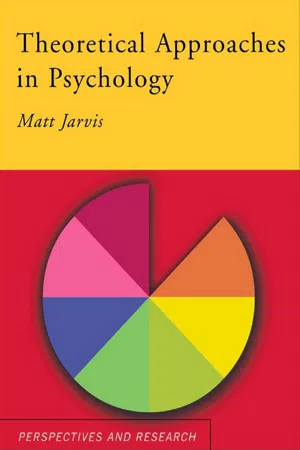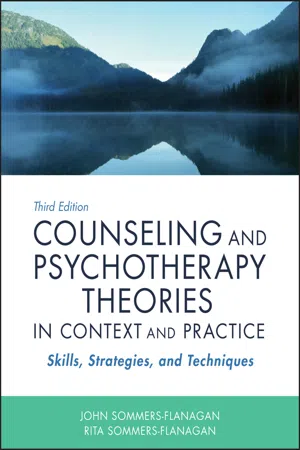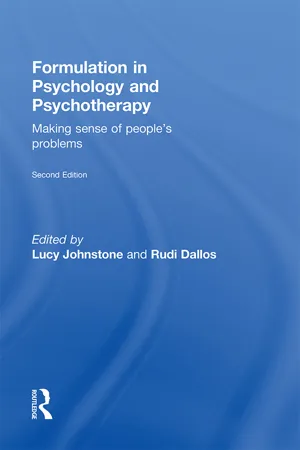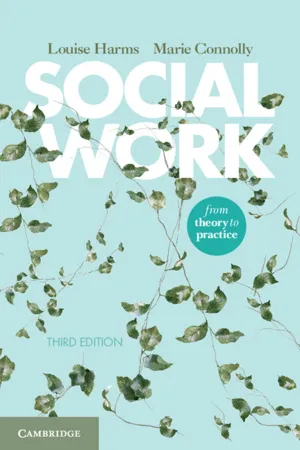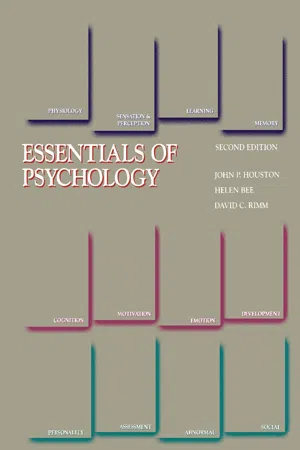Psychology
Psychodynamic Approach
The psychodynamic approach in psychology emphasizes the role of unconscious processes and early childhood experiences in shaping an individual's personality and behavior. It was developed by Sigmund Freud and focuses on understanding the interplay between the id, ego, and superego. This approach also involves exploring defense mechanisms and the influence of unresolved conflicts on mental health.
Written by Perlego with AI-assistance
Related key terms
1 of 5
10 Key excerpts on "Psychodynamic Approach"
- eBook - PDF
The Therapy Relationship
A Special Kind of Friendship
- Richard Hallam(Author)
- 2018(Publication Date)
- Routledge(Publisher)
41 T he theoretical ideas that underlie psychodynamic therapies can be traced to Sigmund Freud and the circle of people surround-ing him at the beginning of the twentieth century. Freud’s early theory highlighted the role of sexual and aggressive instincts in a per-son’s life and how they could be reconciled with external reality. It was a rational part of the mind (the ego) that mediated this difficult task. It did so by constructing “defense mechanisms” in order to maintain a healthy balance between different forces. The superego was another part of the mind that controlled instinctual urges through guilt. Freud later changed his original theory. Other major figures (e.g., Carl Jung, Alfred Adler, Otto Rank, Karen Horney, and Melanie Klein) went in different theoretical directions and developed their own forms of psychodynamic therapy. My aim in this chapter is to give a broad-brush account of what I consider to be the essential characteristics of a Psychodynamic Approach. A survey of the whole field would be an enormous undertaking and so I will focus on the way Freudian ideas were absorbed and became a mainstream therapeutic approach. Psy-choanalysis is the most familiar psychodynamic therapy and I will use it for illustration. The term “psychodynamic” is much broader than “psychoanalytic”, referring to a variety of techniques and theories. CHAPTER FOUR The Psychodynamic Approach 42 THE THERAPY RELATIONSHIP Compared with psychoanalysis, sessions are spaced less frequently and a course of therapy is shorter. Moreover, psychodynamic therapists do not have to undergo their own training analysis with an approved psy-choanalyst in order to qualify to practice. Embedded in most psychodynamic therapies are the following three assumptions. The first is a carry-over from the philosophy of mind that was current in Freud’s day. - eBook - ePub
- Matt Jarvis(Author)
- 2005(Publication Date)
- Routledge(Publisher)
3 Psychodynamic psychology
Key assumptions of the approach Freud’s theories Winnicott’s theories Key application: mental health Contemporary issue: why do we love monsters? Contributions and limitations of the Psychodynamic Approach SummaryKey assumptions of the approach
Have you ever had the experience of doing something out of character such as taking an instant dislike to a stranger, or forgetting to go to an appointment that was important but which you were secretly dreading? If you have, then the chances are that you were influenced by unconscious mental processes—i.e. wishes, emotions, etc. of which you were not aware. You might for example have disliked the stranger because they reminded you of someone else, or forgotten the appointment because you simply did not want to go. The Psychodynamic Approach is an approach to psychology which emphasises these unconscious processes. The way in which a psychodynamic psychologist might look at unconscious processes is well-illustrated by the case of Alex, described by Lemma-Wright (1995).Alex was the older of two sisters. She loved her sister dearly, but had always resented her a little, believing that her family had always doted on her sister while ignoring her. As a child Alex had once become so angry with her sister for being the centre of attention that she dragged her into the sea, frightening her badly. As an adult, Alex frequently found herself feeling obliged to organise things for her sister and to help her out of financial difficulties. One weekend Alex organised sea boat-trip to celebrate her sister‘s birthday. The trip went well, but Alex suffered a panic attack on the boat. She had no idea why until a few days later she had a dream in which she had a fight with a friend (who reminded her of her sister) and wished her dead. It then became clear that - eBook - PDF
Counseling and Psychotherapy Theories in Context and Practice
Skills, Strategies, and Techniques
- John Sommers-Flanagan, Rita Sommers-Flanagan(Authors)
- 2018(Publication Date)
- Wiley(Publisher)
Psychodynamic psychotherapy refers to approaches that emphasize unconscious behavior pat-terns and use insight as a primary therapeutic tool for psychological change. Counseling and Psychotherapy Theories in Context and Practice: Skills, Strategies, and Techniques, Third Edition. John Sommers-Flanagan and Rita Sommers-Flanagan. © 2018 John Wiley & Sons, Inc. Published 2018 by John Wiley & Sons, Inc. Companion website: www.wiley.com/go/sommers-flanagan/theories3e 30 CHAPTER 2 PSYCHOANALYTIC APPROACHES Sigmund Freud has maintained his place as the central figure in psychoanalytic theory since the early 1900s. Some contemporary theorists and practitioners view him as an inspiration. For others, he’s almost reflexively seen in a neg-ative light and his ideas are ignored or unfairly criticized. The fact that speaking his name in public still produces strong emotional and intellectual reactions is a testament to his widespread influence. We begin with a brief examina-tion of his childhood and personal history, because, frankly, Freud himself wouldn’t have it any other way. Sigmund Freud A man like me cannot live without a hobby-horse, a consuming passion—in Schiller’s words a tyrant. I have found my tyrant, and in his service I know no limits. My tyrant is psychology. —Sigmund Freud, 1895, in a letter to W. Fliess Sigmund Freud was born in Freiberg, Moravia, in 1856. He was the firstborn of the union between his father, Jakob, and his mother, Amalie (Jakob’s second wife). Although Jakob had two children from a previous marriage, Sigmund held the favored position of eldest son in a family with three boys and five girls. Jakob, a wool merchant, was authoritarian, while Amalie was protective and nurturing. Due to financial constraints, the family lived together in a small apartment. Freud’s intellectual potential was obvious early on. For example, he and a friend taught themselves Spanish because they wanted to read Don Quixote in its original language. - eBook - PDF
- Rachel Gibbons, Jo O'Reilly(Authors)
- 2021(Publication Date)
- Cambridge University Press(Publisher)
Part I Therapy Theory and Practice Section 1 Psychodynamic Psychotherapy Chapter 1 Psychodynamic Theory: The Development of a Model of the Mind Jo O’Reilly This chapter aims to describe the key contributions that psychoanalytic theory has made to our understanding of the mind. The practice of psychiatry and the development of psychological treatments rest upon how we understand the mind and emotional life. As clinicians working with patients with difficulties in how they feel, relate and think we need an understanding of psychic life in healthy and more disturbed states, just as practitioners of physical medicine need to understand bodily processes in sickness and in health. Since the late nineteenth century psychoanalytic theory has provided a platform from which a series of models of the mind have evolved. An underlying and fundamental tent of this approach is that most of mental functioning occurs at an unconscious level; a finding now widely supported within psychology and neuroscience [1]. The unique contributions of a psychoanalytic approach seek to elucidate and to understand the form and nature of these unconscious processes, both in healthy and more disturbed states of mind. Furthermore, clinical techniques derived from psychoanalysis such as free associ- ation and dream interpretation are specifically aimed at identifying unconscious mental processes and psychoanalysis has a great deal to offer a systematic study of the uncon- scious. Although the terms psychodynamic or psychoanalytic tend to be used in associ- ation with psychotherapeutic treatment, a psychoanalytic approach refers to a school of thought able to provide insights into the workings of the mind far beyond the treatment approaches derived from it. The limits of rational thought and considered volitional action in explaining emotional life are blindingly evident from the complexities, extremities and non-common-sensical nature of much of human behaviour. - eBook - ePub
Formulation in Psychology and Psychotherapy
Making sense of people's problems
- Lucy Johnstone, Rudi Dallos(Authors)
- 2013(Publication Date)
- Routledge(Publisher)
Within the array of ideas and approaches that constitutes the psychodynamic tradition, there is, nonetheless, a commonality of outlook which holds the different strands together (Leiper and Maltby, 2004; Wallerstein, 2002). This is not the enforced unity of ideas that Freud once thought was essential to protect the analytic ideal from watered-down versions or wild practitioners. However, certain key perspectives and shared values constitute the essentials of a coherent approach. At its most basic, what is held in common exists at the level of the perception of the human condition rather than its conceptualisation: it is, in a sense, pre-theoretical. This shared vision forms the basis of a recognizable clinical orientation – a sensibility about the nature of therapeutic practice – rather than an articulated psychological paradigm. Such a general way of looking at clinical material leaves a lot of scope for diversity in what an ‘accurate’, or even a simply useful, formulation might look like.Core features of a Psychodynamic ApproachWhat ideas constitute the core of the Psychodynamic Approach? Perhaps the most fundamental one is the focus on psychological or emotional pain. Life is thought of as a difficult and demanding process and the psyche is constructed in the struggle to deal with it. What is ‘dynamic’ is the turbulence created in the currents of mental life by these struggles. Means of avoiding pain are developed: ways of seeing, thinking, feeling and behaving can all serve this purpose. Much of this activity takes place out of awareness. There is an ‘internal world’ constituted differently from external reality, the unconscious elements of which have a fundamental influence on the way we live our lives. These unconscious attempts to avoid pain often fail, but since our awareness is limited, they are nonetheless repeated again and again. Failing defences are what give form to and maintain patterns of psychological disorder. Therapy is about getting in touch with thoughts and feelings which were previously ‘warded off’, kept hidden from the conscious mind because they seemed to be too much to deal with. Psychodynamic therapy is about helping the client to ‘re-formulate’ what they are experiencing in a more inclusive way, and to tolerate the discomfort that this involves. The understanding that the therapist and client develop about these difficulties expands the client’s awareness and opens up new options for managing conflict. The client’s capacity to bear emotional pain and cope constructively with dissatisfaction is enhanced, and the ability to reflect on and be curious about their experience is developed. - eBook - PDF
Social Work
From Theory to Practice
- Louise Harms, Marie Connolly(Authors)
- 2019(Publication Date)
- Cambridge University Press(Publisher)
In practice, it relates to how, together with the client, we incorporate the past in understanding what is going on for them today. CHAPTER 4: PSYCHODYNAMIC AND PERSON-CENTRED APPROACHES 75 Our inner drives and motivations If our inner lives are in constant dynamic interaction with the external world, our conscious and unconscious lives are driven or motivated by various concerns, pri- orities and anxieties. Theories about our unconscious and conscious drives have shifted significantly over the century and a half of psychodynamic thinking that has taken place. From seeing our drives as primarily psychosexual, in the early days of Freudian thinking, we are now in an era where safety and security are seen as pri- mary drives. Perhaps we see the social concerns of the day reflected in our under- standing of the infant’s early development and inner world: from sexually repressed Vienna through to our risk-obsessed society. Our psychosexual and psychosocial drives Freud (1975) placed psychosexual drives at the core of his theories, arguing that each phase of early development of the self was driven by sexual preoccupation: in respect of the oral to anal and through to the genital phases of development, Freud and his colleagues articulated theories about the conflicts and potential neuroses arising from each of these transitions. Further reading can help you understand the details of the Oedipal and Electra complexes, for example, and of his elaboration of the pleasure principle and the death instinct (e.g. see Freud 1975, a collection of Freudian writings edited by Strachey). Many came to question Freud’s theory of psychosexual drive as the primary motive in human development and behaviour. - David Capuzzi, Mark D. Stauffer, David Capuzzi, Mark D. Stauffer(Authors)
- 2021(Publication Date)
- Wiley(Publisher)
This shift, in turn, cultivated the evolution of diverse family and relationship therapy models, with each taking a somewhat different perspective of the relative impacts of individual and systemic forces. Psychodynamic theory evolved from core concepts of psychoanalysis and was based on the groundbreaking work of both Sigmund Freud and Carl Jung. Psychoanalysis was exclusively an individually oriented treatment approach, centered on enhancing personal awareness and revealing unconscious influences through extensive, time-consuming exploration of the inner self. Partici- pants in this treatment process would often attend therapy several times a week, sometimes for years. Psychodynamics used a more application-oriented approach, focusing more on how these unconscious patterns and constructs manifested in the present and impacted behaviors. Through exploration of past influences and identification of unresolved conflicts, clients were encouraged not only to recognize patterns but also to seek to revise them in the present as a means of allevi- ating problems and conflicts. Frequency of sessions and duration of treatment were reduced under psychodynamics, taking a more proactive approach to treatment. Despite some differences in the- oretical constructs and application, both psychoanalytic and psychodynamic theory “emphasize the causal relationship between early developmental experiences, thoughts, feelings and behaviors that characterize the mental life of adults” (Berzoff, 2011, p. 46). As such, these terms are sometimes used interchangeably, though they are, in fact, different theoretical approaches. Psychodynamics were significantly impacted by the influences of GST, as its core principles were now being considered from a systemic viewpoint.- eBook - PDF
- Douglas Bernstein, , , (Authors)
- 2015(Publication Date)
- Cengage Learning EMEA(Publisher)
psychoanalytic theory Freud’s view that human behavior and person-ality are determined largely by psy-chological factors, many of which are unconscious. Psychodynamic Approach A view developed by Freud that empha-sizes unconscious mental processes in explaining human thought, feel-ings, and behavior. TRY THIS Copyright 2016 Cengage Learning. All Rights Reserved. May not be copied, scanned, or duplicated, in whole or in part. Due to electronic rights, some third party content may be suppressed from the eBook and/or eChapter(s). Editorial review has deemed that any suppressed content does not materially affect the overall learning experience. Cengage Learning reserves the right to remove additional content at any time if subsequent rights restrictions require it. 458 Personality id According to Freud, a personal-ity component containing basic in-stincts, desires, and impulses with which all people are born. pleasure principle The operating principle of the id, which guides people toward whatever feels good. ego According to Freud, the part of the personality that makes compro-mises and mediates conflicts between and among the demands of the id, the superego, and the real world. reality principle The operating prin-ciple of the ego, which takes into account the constraints of the social world. superego According to Freud, the component of personality that tells people what they should and should not do. defense mechanisms Unconscious tactics that either prevent threat-ening material from surfacing or disguise it when it does. The Structure of Personality Freud concluded that people have certain basic impulses or urges, related not only to food and water but also to sex and aggression. Freud described these impulses and urges with a German word that translates as “instinct,” but he did not believe that they are all inborn and unchangeable, as the word instinct might imply (Ryckman, 2013). - eBook - PDF
- Danny Wedding, Raymond Corsini(Authors)
- 2018(Publication Date)
- Cengage Learning EMEA(Publisher)
These include: 1. an assumption that that all human beings are motivated in part by wishes, fantasies, or tacit knowledge that is outside of awareness (this is referred to as unconscious motivation); 2. an interest in facilitating awareness of unconscious motivations, thereby increasing choice; 3. an emphasis on exploring the ways in which we avoid painful or threatening feel-ings, fantasies, and thoughts; 4. an assumption that we are ambivalent about changing and an emphasis on the im-portance of exploring this ambivalence; 5. an emphasis on using the therapeutic relationship as an arena for exploring cli-ents’ self-defeating psychological processes and actions (both conscious and unconscious); 6. an emphasis on using the therapeutic relationship as an important vehicle of change; and 7. an emphasis on helping clients to understand the way in which their own construction of their past and present plays a role in perpetuating their self-defeating patterns. The purpose of this chapter is to introduce psychoanalytic theory as a framework for conceptualizing human behavior and conducting psychotherapy. We seek to em-phasize not only those concepts that are universally upheld but also the controversies, unique perspectives, and ongoing dialectics between and within different schools of thought that have been a part of psychoanalysis since its beginning. Basic Concepts The Unconscious One of Freud’s most important insights was that “we are not masters of our own houses.” By this, he meant that rational understanding of the factors motivating our actions often proves inadequate. Freud understood the unconscious as an area of psychic functioning Copyright 2019 Cengage Learning. All Rights Reserved. May not be copied, scanned, or duplicated, in whole or in part. Due to electronic rights, some third party content may be suppressed from the eBook and/or eChapter(s). - eBook - PDF
- John P. Houston, Helen Bee, David C. Rimm(Authors)
- 2013(Publication Date)
- Academic Press(Publisher)
CHAPTER THIRTEEN Treating psychological problems A Psychodynamic Approach: psychoanalysis Psychoanalytic treatment Evaluation of psychoanalysis Existential—humanistic therapies Client-centered therapy Gestalt psychotherapy Behavior therapy Behavioral treatments Cognitive behavior therapy Evaluation of behavior therapies The eclectic approach Some other alternatives Group treatment The community mental health approach Medical approaches Drug therapies Physical treatments Broad spectrum approaches to therapy: two examples Summary Key terms Comparing the psychological approaches Twice a week for the past 18 months, Alice has met with her psychiatrist, who is a psychoanalyst, or follower of Sigmund Freud. During these ses-sions, Alice lies on a couch and says anything that comes to mind. Some-times she engages in free association. Sometimes she describes her dreams, Often, her therapist interprets what she says in relation to her early child-hood experiences. She finds that more and more she sees the therapist as a kind of father figure. Her analyst encourages this because he believes this will lead to insight, which will help Alice get better. Every Wednesday, Bob sees a Rogerian psychologist at the university's counseling center. His therapist is very good at drawing him out of himself and helping him understand how he really feels about himself and others. She never tells him how he is feeling. Instead, she mirrors what he says and how he comes across, so that he ends up understanding what is going on inside himself. She seems to be a very accepting, nonjudgmental per-son. At the same time she lets Bob know that he is responsible for his thoughts and emotions. She believes that relating to Bob in this way will lead to his emotional growth. Tina has been seeing a behavior therapist for the past three months. After several interviews, she and her therapist agreed that she was very timid in certain social encounters.
Index pages curate the most relevant extracts from our library of academic textbooks. They’ve been created using an in-house natural language model (NLM), each adding context and meaning to key research topics.

